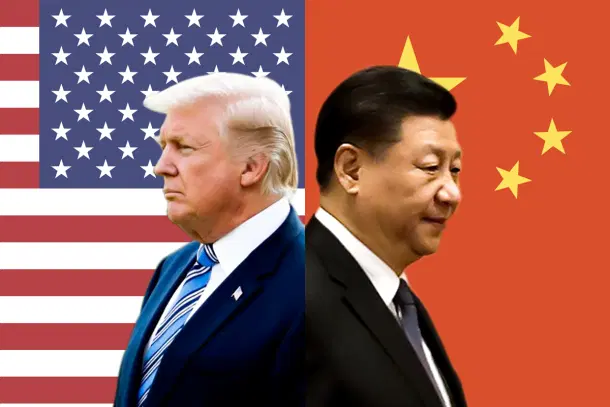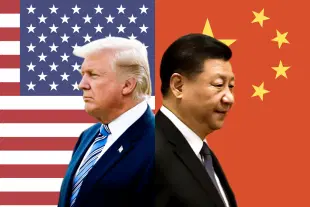World
Why New US Tariffs Might Hit Chinese Factories More Than American Wallets
Prof. Vidhu Shekhar
Apr 06, 2025, 08:58 AM | Updated Apr 08, 2025, 01:08 PM IST
Save & read from anywhere!
Bookmark stories for easy access on any device or the Swarajya app.


U.S. markets have reacted sharply to the US's newly unveiled reciprocal tariff regime. Stocks sold off, oil prices dropped, and risk sentiment soured. The reaction was loud, fast, and, in my view, deeply miscalibrated.
The market appears to be treating these new tariffs as if we are back in 2018- expecting inflationary pressure, higher costs for American consumers, and a looming trade war spiral. But this is 2025, and the global macro backdrop is completely different. Most importantly, China, the primary target of the tariffs, is no longer a booming export engine with pricing power. It is now a deflationary giant struggling with chronic overcapacity.
And that changes everything.
Deflationary China Not in the Shape for Heavy Push Back
The central point investors are missing is that China is in deep economic trouble currently. It is struggling with deflation (i.e. falling prices) across the economy. Factory gate prices in China have been falling for more than 10 consecutive months, and the producer price index (PPI) is firmly in negative territory - clear signs of a deflationary export environment.
There is a tremendous buildup of excess industrial capacity - factories producing far more than the market can absorb. Domestic demand is not just unable to keep up; it is actively weakening under the weight of high household and local government debt. Chinese consumer inflation has turned negative, with the Consumer Price Index (CPI) declining by 0.7% in February 2025.
All this is despite the massive monetary and credit push China has been taking to stimulate growth.
In this environment, Chinese manufacturers cannot afford to push back against U.S. tariffs. A pile-up of unsold inventory makes them very vulnerable to any export price negotiations. They cannot risk losing export orders, even if it means selling goods at a loss, recovering variable cost at least. Delaying shipments or losing market share is not an option - they need to keep factories running to avoid further stress. Even Beijing would prefer that exporters absorb the pain rather than see rising joblessness.
What does this mean in practice? Chinese exporters will absorb most of the new tariffs imposed by the U.S., not U.S. consumers. They will do this through margin reduction, price cuts, and currency depreciation if needed. Their focus now is volume, not profitability.
The U.S., in turn, gets a stream of tariff revenue, a marginal fiscal boost, and a symbolic political win - without triggering domestic inflation or a meaningful rise in consumer prices.
Functionally, this is a transfer of economic value from Chinese manufacturers directly to the U.S. Treasury. And with the U.S. facing rising interest costs and persistent deficits, even a modest boost in customs revenue will be politically useful.
Short-Term U.S. Advantage, Long-Term Global Risk
That is not to say there will not be pain elsewhere. China, clearly, is the biggest loser in this configuration. It is now forced to subsidize its own export sector more aggressively while its trade surplus with the U.S. comes under stress. Emerging markets that are deeply tied to Chinese supply chains will feel the ripple effects too. But for the U.S., the short-term impact may not only be benign - it may be mildly beneficial.
To be clear, this isn’t an endorsement of tariffs as long-term economic policy. Over time, supply chain fragmentation, retaliatory trade measures, and reduced global cooperation will take their toll. The U.S. may win the short-term optics, but geopolitical trust and long-term trade integration will suffer. Those are real costs, but they play out over the years - not quarters.
In the meantime, the market’s kneejerk selloff appears to be based on assumptions that no longer hold. This is not an inflation overheating world. This is a world teetering on the edge of disinflation. And in a disinflationary world, tariffs absorbed by deflationary exporters can act almost like a fiscal transfer mechanism.
Equities may rebound as the fear fades and investors recalibrate. The U.S. dollar, paradoxically soft during the initial reaction, could surge as capital flows chase relative strength. Gold and Treasuries, caught in the confusion, may regain direction as rate expectations shift. And perhaps most importantly, China may be forced to accelerate structural reforms or risk deeper economic instability.
What It Means for India
For India, the shakeout in China may have a positive outcome. As global investors rotate away from Chinese exposure, India is well-positioned to absorb a larger share of emerging market flows. Its relative macro stability, improving manufacturing base, and alignment with U.S. strategic interests make it a natural beneficiary.
More importantly, the global search for "China-plus-one" supply chains could gain new momentum. India may attract incremental FDI, have favourable trade terms with the U.S., and reinforce its strategic appeal. In the short term, this could translate to stronger capital inflows and increased geopolitical relevance, albeit with some volatility as capital reallocates.
Final Thought: Optics vs. Mechanics
Markets got the optics right - Trump is escalating a global trade confrontation. But they got the mechanics wrong. In 2025, tariffs imposed on a deflationary China will not stoke inflation. They do not shock consumers. They quietly squeeze China and give the U.S. a temporary upper hand.
The question is not whether the tariff war is a risk. It is. The question is when the risk manifests and who bears the cost. For now, China is bearing most of it. And the U.S. is holding the stronger hand - at least in the short term.
Dr. Vidhu Shekhar holds a Ph.D. in Economics from IIM Calcutta, an MBA from IIM Calcutta, and a B.Tech from IIT Kharagpur. He is currently an Assistant Professor in Finance & Economics at Bhavan's SPJIMR, Mumbai. Previously, he has worked as an investment banker and hedge fund analyst. Views expressed are personal.





